Journal of the NACAA
ISSN 2158-9429
Volume 10, Issue 1 - June, 2017
Assessing Research and Education Needs to Improve Equine Gastrointestinal Health
- Coffin, D. , Extension Educator, University of Maine Cooperative Extension
Causey, R., Associate Professor, University of Maine
Staniar, B., Associate Professor, The Pennsylvania State University
Williams, C., Associate Professor, Rutgers University
McKeever, K., Professor, Rutgers University
Gradil, C., Extension Professor, University of Massachusetts at Amherst
Nadeau, J., Associate Professor, University of Connecticut
Sanchez, A., Associate Professor, Cummings School of Veterinary Medicine at Tufts
Lichtenwalner, A. , Associate Professor, University of Maine Cooperative Extension
Biddle, A., Assistant Professor, University of Delaware
ABSTRACT
Gastrointestinal (GI) health is central to avoiding many equine diseases and disorders. An online survey of 246 northeast US horse owners about their most common equine health issues and their level of interest in learning more to reduce colic through changes in horse management practices was conducted. While over 50% of respondents feel they are knowledgeable about equine GI health, 95% indicated they were interested in learning more about this topic. Eighty-seven percent feel research and education on equine GI health is the most or a very important long-term objective to improving the overall health and performance of horses. As a result of this survey, the Equine Clinical Studies Coordinating Committee for the Northeastern US will develop research proposals to investigate the equine intestinal biome and its relevance to all aspects of health, but especially equine gastrointestinal health.
Introduction
Equine clinical research is limited by the expense of the horse as an experimental animal. Equine studies frequently involve small groups of horses, as larger numbers exceed the resources of many investigators. In addition, large epidemiological and clinical studies in horse populations are logistically difficult to perform. Nevertheless, large studies in horses have generated valuable information, and are among the more reliable in the clinical literature. The greater power of large studies directly benefits horses by improving diagnosis and therapy (Simoneit et. al., 2011).
In addition, the Northeastern United States is home to a strong equine industry, supported by equine research programs in veterinary colleges, and the animal and/or veterinary science departments of public universities. Increased collaboration and pooling of resources between these institutions could strengthen equine research by facilitating large clinical studies. In addition, it could assist development of new diagnostic and therapeutic products by the animal biotechnological and pharmaceutical sectors. However, such collaborative studies pose significant logistical and scientific difficulties, primarily through the effort necessary to establish strong partnerships between widely dispersed investigators.
To promote these collaborations the authors established the Equine Clinical Studies Coordinating Committee (ECSCC) under the USDA Multistate Research Activity Program, as defined by the Agricultural Research, Extension, and Education Reform Act of 1998. The act provides for the regional associations of State Agricultural Experiment Directors (SAESD) to serve as coordinating entities for multistate research activities and to provide for “…cooperative research employing multidisciplinary approaches in which a state agricultural experiment station, working with another state agricultural experiment station, the Agricultural Research Service, or a college or university, cooperates to solve problems that concern more than one state.” The ECSCC was approved by the Northeastern SAESD, which consists of directors from Connecticut, Delaware, District of Columbia, Maine, Maryland, Massachusetts, New Hampshire, New Jersey, New York, Pennsylvania, Rhode Island, Vermont, and West Virginia. The ECSCC includes faculty from Animal and/or Veterinary science departments, and cooperative extension of public universities in Maine, Pennsylvania, New Jersey, Massachusetts, Connecticut, and Delaware and from the Cummings School of Veterinary Medicine at Tufts University.
At the first meeting of the ECSCC, gastrointestinal (GI) health was identified as a potential area both of shared interest to researchers and of significant importance to stakeholders. It is generally accepted that GI health is central to equine wellness, and helps prevent many equine diseases and disorders. However, it was the commonly held view of the committee that few horse owners are well informed about this topic, in spite of its impact on equine athletic performance, longevity, and overall well-being. In addition, recent interest in the equine intestinal microbiome (Ericsson et al., 2016; Coverdale, 2016; Juliand and Grimm, 2016) and its impact on GI health appeared to present many opportunities for cutting edge research to improve equine wellness.
However, before committing resources or requesting funding, it was felt necessary to survey horse owners in the Northern Eastern US to gauge their knowledge of GI health, and their support for GI research. For this reason the authors developed an online survey for equine owners to assess their overall knowledge of GI health, and to determine if pursuit of GI research would coincide with stakeholder needs.
Methods
The authors prepared an online survey asking equine owners about their understanding of gastrointestinal health issues of their animals and the owners’ perceived need to address specific problems arising from disturbances of the intestinal biome, and the perceived value of intestinal probiotics. The anonymous survey was offered online by the University of Maine Cooperative Extension (UMaine Extension), with approval obtained from the University of Maine Institutional Review Board. The link was distributed to horse owners throughout the Northeast via UMaine Extension distribution lists of equine industry groups and horse owners, using Constant ContactTM. The invitation was also published in equine-related print media, social media pages of regional university and extension offices and Cooperative Extension e-newsletters. Once the link was followed, participants approved an informed consent form and took the online survey. The goal was to receive up to 500 responses.
Results
A total of 246 completed surveys were received. In a subset of 58 emailed invitations from UMCE, 15 (26%) of recipients opened the email with the survey invitation. Due to the anonymous nature of the survey, it was not possible to determine where in the North East the respondents resided. The findings are reported using descriptive statistics, with frequency distributions of the responses collected.
Overall, the responses revealed that 60% of the owners fed a supplement to influence GI health. Supplement choice was based on the respondent’s own research (63%) or information from a veterinarian (49%), a nutritionist (20%), a trainer (13%) or a friend (16%). While over 50% of respondents felt that they were knowledgeable about equine GI health, 95% indicated they were interested in learning more about this topic. Of all respondents, 87% felt research and education on equine GI health was the most or a very important long-term objective for improving the overall health and performance of horses. More detailed results of the survey follow.
Owners Information:
The majority of respondents (96%) own their own horses, and 61% considered themselves recreational riders, 24% competitive riders, 27% stable managers and 27% trainer/instructors. They care for an average of 4.8 horses per respondent with the majority (71%) caring for between 2 and 10 animals. Also, 30% describe themselves as having an intermediate level, 52% an advanced level and 16% a professional level of experience with horses. Highest level of education attained was 34% high school, 14% associates degree, 33% Bachelor’s degree, 24% Master’s and 4% doctoral degree.
Current Horse Care:
Respondents were asked to indicate the amount of hay and grain fed to their horses each day in either pounds or quarts. Responses (Figure 1) indicate that many respondents used both pounds and quarts to report feeding practices. Specifically, 80% used pounds to report grain fed. While 61% used quarts for grain fed, 67% used pounds of hay and 79% used flakes of hay. In addition, 41% fed 1 to 3 pounds of grain, 40% fed less than a quart and 39% fed 1 to 3 quarts of grain. Of those using pounds of hay, 49% fed free choice and 28% using flakes of hay fed it free choice. The majority (70%) of horse owners fed lower levels of grain (less than 3 pounds) and 70% reported free choice access to hay.
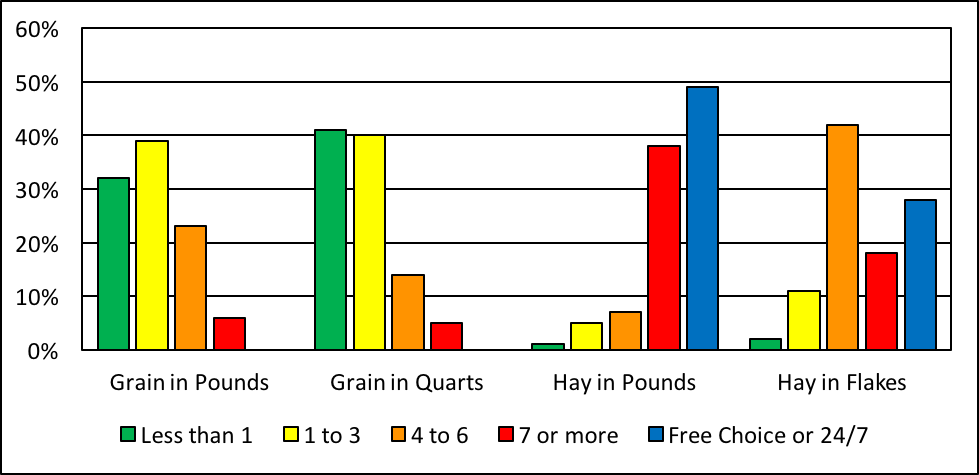
Figure 1: Percent of horses fed different amounts of grain and hay per day.
Respondents were also asked the amount of time their horses were exercised and the stocking density in pastures (Figure 2). Many respondents (76%) reported time in an exercise lot but more (96%) answered time in a pasture. The results show that when pasture is not available, 22% keep their horses in an exercise lot three hours or less, while 10% keep their horses in pasture three hours or less. Most respondents (54%) had 1 to 3 acres per horse of pasture with 80% having one or more acres per horse.
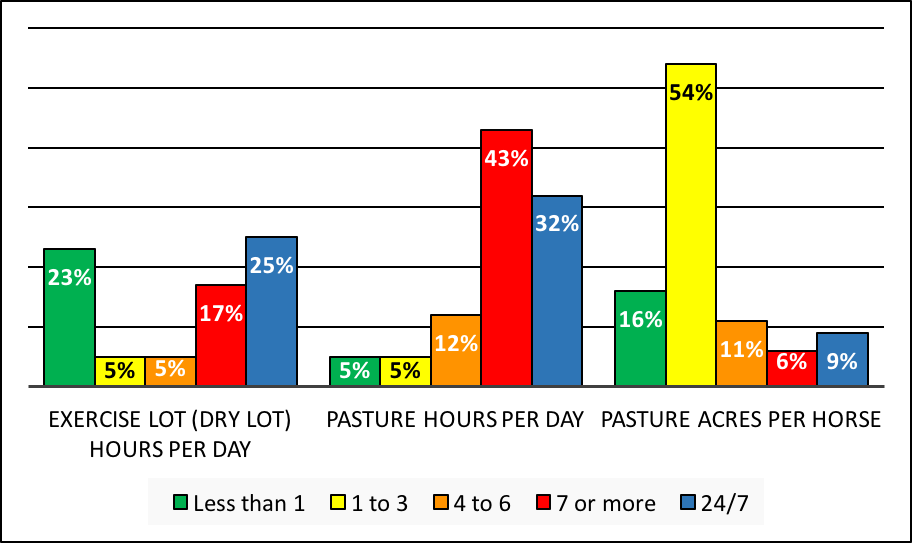
Figure 2: Time in exercise lot or pasture (hours) and pasture stocking density (acres per horse) percent.
Horse Health Concerns:
When asked if any of their horses had any of a list of nutrition-related conditions in the past five years, 37% reported colic, 36% observed weight loss or poor condition, 32% observed obesity, 21% reported diarrhea, 20% reported ulcers and 19% reported laminitis. Figure 3 shows the most important to least important equine health concerns that equine owners have for their animals. The vast majority (91%) are most concerned with colic followed by hoof problems (78%).
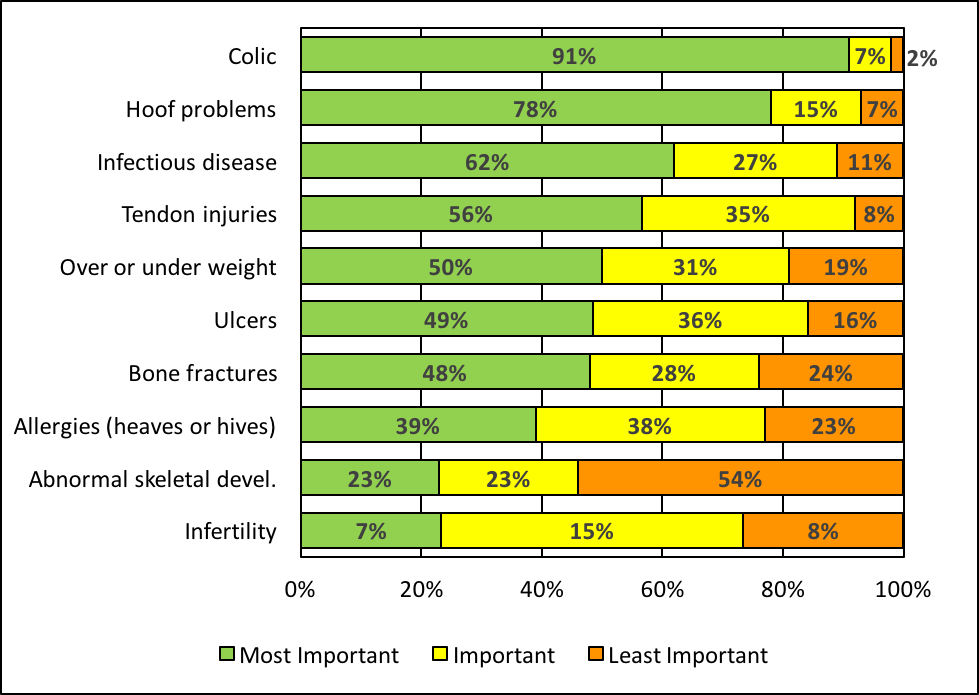
Figure 3: Equine health concerns.
Current Prevention and Treatment of Gastrointestinal Issues
The majority of horse owners either never or rarely (58%) fed a supplement to influence the gastrointestinal health of their horses, while 44% fed one often or always (Figure 4).

Figure 4: How often supplements are fed to influence gastrointestinal health (percent).
When asked to select all types of supplements fed for gastrointestinal health from a list, the majority (58%) used probiotics. However, 24% selected the category “other” that included brand names for many of the supplements listed along with antibiotics, prebiotics and enzymes (Figure 5).
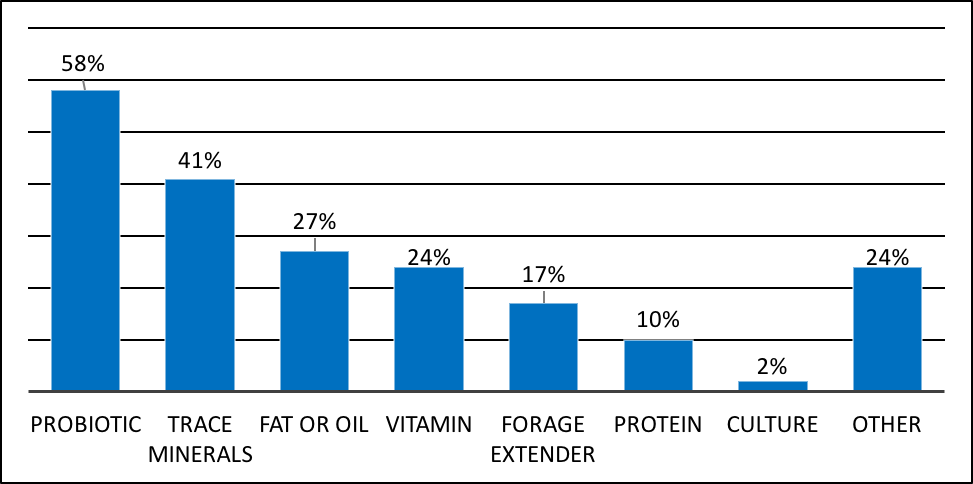
Figure 5: Type of supplement fed for gastrointestinal health (percent).
A small percent (15%) of those who treat or manage nutrition-related problems indicated that they spent over $1,000 per year, 57% spent between $100 and $999, and 28% spent less than $100.
Sources of Horse Health Information:
When asked how knowledgeable they were about equine gastrointestinal health, 10% of respondents indicated that they know a lot, 44% know enough for their needs, 44% know a little, but need to know more, and 2% indicated they know nothing about equine gastrointestinal health.
When asked how they selected the supplements for their animals, 63% of respondents based the selection on their own research, 50% by veterinary recommendation, 20% by nutritionist recommendation, 16% based on friend’s recommendation, 15% based on trainer’s recommendation, 5% based on their farrier’s recommendation and 3% based on their Extension specialist recommendations.
Figure 6 shows what sources of information respondents regarded as a “most trusted ” “trusted”, or “least trusted source” of information about equine health. The majority (94%) viewed their veterinarian as a “most trusted source”, followed by 74% regarding their farrier as a “most trusted source”.
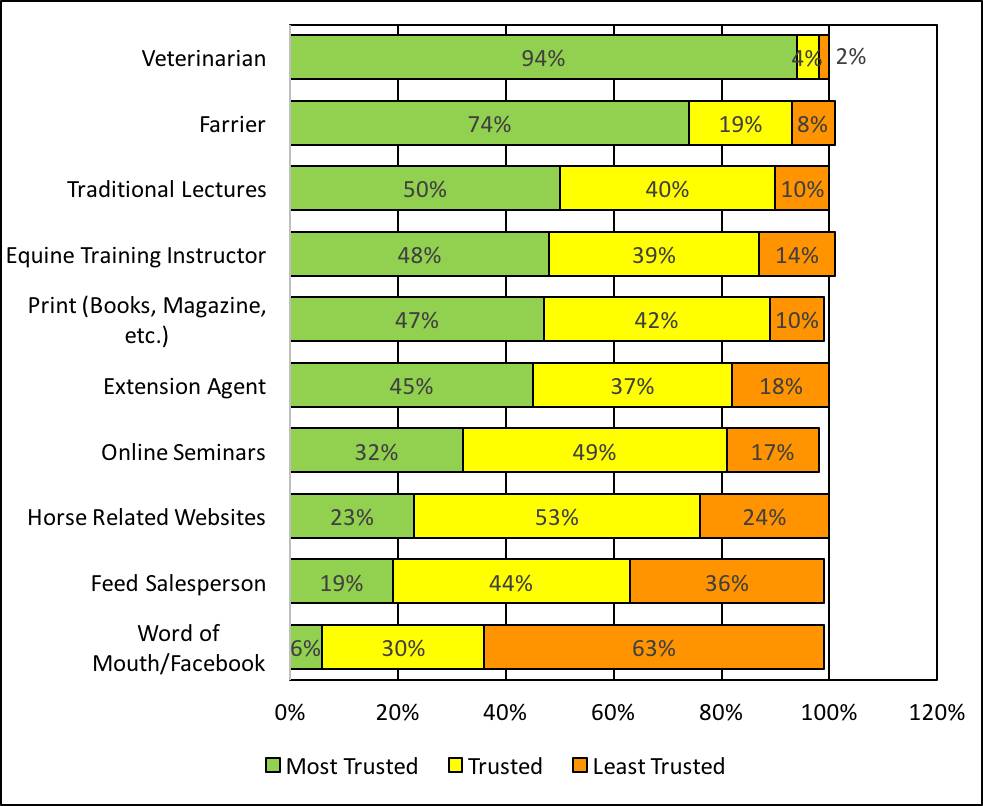
Figure 6: Trusted sources of information about equine health (percent).
When asked to assess the importance of research and education to improve the long-term health and performance of their horses, 87% felt it was either most or very important (Figure 7).

Figure 7: Importance of research and education in gastrointestinal health to improve long-term health and performance of horses (percent).
Discussion
Overall these data would appear to support the ECSCC proceeding to pursue collaborative research in the area of equine gastrointestinal health, with 87% of respondents feeling that research and education on equine GI health was the most or a very important long-term objective for improving the overall health and performance of horses.
The finding that 70% of horse owners apparently feed less than 3 lbs of grain feeding was encouraging (Figure 1), since high fiber diets appear to be beneficial for equine health through their effect on equine gut microbiota (Dougal et al., 2014; Milinovich et al., 2008). However, it is perhaps concerning that almost 25% of all horses receive less than 3 hours in a dry lot or pasture (Figure 2). Access to regular exercise through dry lot or pasture time helps maintain overall well-being of equids and reduces the incidence of colic (Hilyer et al., 2002; Archer et al., 2006). Not surprisingly, colic ranked as the most important equine health concern (Figure 3) which is consistent with other studies (Traub-Dargatz et al., 1991). It is interesting that only 25% of owners feed supplements always. It appears that the age of horses is increasing, with an increasing population of geriatric horses. It is therefore possible that supplementation of older horses, especially to maintain weight, may lead to an overall increase in supplementation in the future (Argo, 2016). Over half of the respondents reported feeding probiotics. This would appear to be an area for future research since the efficacy of the various forms of probiotics will continue to require validation. It appears, however, that most respondents identified veterinarians and farriers as the most trusted source of information for health related issues, while ranking extension agents substantially lower. It is possible that many owners have limited contact with their extension agent, but all will regularly see their veterinarian or farrier (Figure 6). However, 87% stressed the need for more research in gastrointestinal health.
Based on the survey results, the ECSCC felt justified in pursuing collaborations for research on gastrointestinal health, especially the equine microbiome. This area is increasingly recognized as influencing many aspects of equine health and disease (Ericsson et al., 2016; Coverdale, 2016; Juliand and Grimm, 2016). To this end, the ECSCC elected to move towards developing a multistate research project involving the equine microbiome. At their most recent meeting in September 2016, the ECSCC cataloged the potential impacts of gastrointestinal research. The impacts included:
- Establishment of evidence-based best feeding practices focusing on improving nutrient access for specific equine populations.
- Development of evidence-based best management practices focusing on improving gut health for specific equine populations.
- Deeper understanding of challenging gut health issues leading to targeted therapeutics.
In addition, potential research objectives were discussed, which included:
- To understand the mechanisms of the equine gut microbiome in nutrient utilization, in order to improve nutritional performance of targeted populations of horses.
- To identify management practices that foster improved equine gut health.
- To determine the effect of supplements, probiotics and prebiotics on the equine microbiome
- To characterize interactions associated with growth, health and disease states, enabling deeper understanding of the horse-microbiome conversation, and leading to the development of targeted therapeutics.
- To characterize anatomical features of the microbiome in the skin, uterus, gut, mucus, etc.
- To determine the effects of the microbiome on the environment.
- To determine the roll of the animal microbiome on human health due to companion and farm animal contact.
- To develop a means of determining the knowledge of equine farmers/owners on the equine microbiome and the need for additional outreach programs.
Literature Cited
Archer, D. C., and Proudman, C. J. (2006). Epidemiological clues to preventing colic. The Veterinary Journal. 172:29-39.
Argo, C.M. (2016). Nutritional Management of the Older Horse. Veterinary Clinics of North America Equine Practice. 32:343-54.
Coverdale, J. A. (2016). Horse Species Symposium: Can the microbiome of the horse be altered to improve digestion? Journal of Animal Science. 94:2275-81.
Dougal, K., de la Fuente, G., Harris, P. A., Girdwood, S. E., Pinloche, E., Geor, R. J., Nielsen, B. D., Schott, H. C., Elzinga, S., and Newbold, C. J. (2014). Characterisation of the faecal bacterial community in adult and elderly horses fed a high fibre, high oil or high starch diet using 454 pyrosequencing. PLoS ONE 2014; 9:e87424.
Ericsson, A. C., Johnson, P. J., Lopes, M. A., Perry, S. C., and Lanter, H. R. (2016). A microbiological map of the healthy equine gastrointestinal tract. PLoS ONE 2016; 11:e0166523.
Julliand, V., and Grimm, P. (2016). HORSE SPECIES SYMPOSIUM: The microbiome of the horse hindgut: History and current knowledge. Journal of Animal Science. 94:2262-74.
Hillyer, MH, Taylor, FG, Proudman, CJ, Edwards, GB, Smith, JE, French, NP (2002). Case control study to identify risk factors for simple colonic obstruction and distension colic in horses. Equine Veterinary Journal. 34:455-63.
Milinovich, G. J,, Burrell, P. C., Pollitt, C. C., Klieve, A. V., Blackall, L. L., Ouwerkerk, D., Woodland, E., and Trott, D. J. (2008). Microbial ecology of the equine hindgut during oligofructose-induced laminitis. The ISME Journal. 2:1089 – 1100.
Simoneit, C., Heuwieser, W., and Arlt, S. (2011). Evidence-based medicine in bovine, equine and canine reproduction: quality of current literature. Theriogenology 2011; 76:1042-1050.
Traub-Dargatz, J. L., Salman M. D., and Voss, J. L. (1991). Medical problems of adult horses, as ranked by equine practitioners. Journal of the American Veterinary Medical Association. 198:1745–1747.
